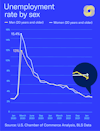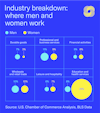 Stephanie Ferguson
Stephanie Ferguson
Director, Global Employment Policy & Special Initiatives, U.S. Chamber of Commerce
Published
April 27, 2022
Companies of every size and industry and across every state are facing unprecedented challenges trying to find enough workers to fill open jobs. The latest data shows that we have over 10 million job openings in the U.S., and around 6 million unemployed workers.
One contributing factor to the ongoing worker shortage crisis is that many women have not returned to the workforce in the wake of the pandemic. In fact, there are an estimated one million women missing from the labor force compared to February 2020.
To help make sense of the impact of women leaving the labor force our Data Deep Dive: A Decline of Women in the Workforce explores the latest data on women in the workforce and the impact of childcare breakdowns.
Women in the U.S. Workforce
Women entered the workforce in meaningful numbers in the 1920s, but it was mostly single women. Participation amongst both single and married women climbed for the next 50 years as education became more available, demand for workers increased, and the ability to postpone starting a family became more readily available.
Today, women represent 47% of all U.S. employees and it’s obvious that women are integral to our modern workforce. However, despite the strong presence of working women, inequities remain—and in some cases are expanding. These are worrying trends as the U.S. economy recovers from the COVID-19 pandemic and faces an unprecedented labor shortage.
Just before the pandemic in February 2020, 59% of women over the age of twenty were participating in the labor force. Data from 2019 shows that 72% of all mothers were participating. To compare, 71% of all men and 93.3% of all fathers were participating in the pre-pandemic workforce.

Both men and women suffered a 3% drop in labor force participation at the height of the pandemic. But more than two years later, men have returned to work at a higher rate than women. Historically, men have higher rates of unemployment compared to women. But in April 2020 as the pandemic took hold, women’s unemployment surpassed men’s by 2.5%. Today, women’s unemployment rate lags men's by only .1% but the labor force participation rate for women is still a full percentage point lower than it was pre-pandemic.
What’s Causing Women Not to Work?
There are several factors contributing to the slower return of women to the workforce. All of them are helping to fuel a workforce shortage that is unsustainable for the American economy and will disadvantage women in the long run.
More women are staying home to care for children
As childcare providers have reduced capacity and hours due to pandemic challenges, many parents have been forced to leave work to care for their children. According to a U.S. Chamber of Commerce Foundation study, 58% of working parents reported leaving work because they were unable to find childcare solutions that met their needs. Furthermore, 32% of women cited the need to be home to care for family members as a barrier to returning to work.
In December 2020, one in four childcare providers were closed and in September 2020, 67% of school aged children were enrolled in distance learning, or attending school remotely. In anticipation of childcare disruptions, Congress provided unemployment insurance benefits to parents who were unable to work due to reasons related to COVID-19, one of which was the need to stay home to care for a child. Many parents, and in particular many women, left their jobs to do just that.

Childcare continues to be a leading obstacle for reentering the workforce, even though businesses and schools have mostly reopened. This is because when deciding which parent should stay home and which parent should return to work, the most common choice is typically the mother.
Women in the U.S. earn 18 cents per dollar less than men. Over the course of a week, women’s median wages trail men’s by $172, accumulating to an $8,900 deficit annually. This ‘salary gap’ can contribute to the decision for a working mother to stay home with their child rather than to pay for childcare.
Views on work-life balance are shifting
While lower wages and insufficient childcare pose challenges to bringing women back into the workforce, these are not the only obstacles. In a recent survey, 45% of workers reported leaving the workforce because they lacked flexibility in the workplace. A USA Today survey found that U.S. workers strongly prefer working from home—so much, in fact, that 25% said they would resign if forced to return to the office.
When women take the brunt of childcare responsibilities, short term absences from work—like leaving early or taking sick days to care for kids—can be misconstrued as a mother not prioritizing work or being unable to manage the work/life balance. Long-term absences can also often cause women to miss promotion or growth opportunities, further widening the wage gap.
Women are more vulnerable to pandemic layoffs
Women are 10% more likely than men to serve in lower-paying jobs, and are more likely to work in the education and healthcare industry. During pandemic shutdowns, the workers most vulnerable to being laid off were low paid workers in the leisure and hospitality, government, and education and health services industries—all sectors in which women are overrepresented.
When examining gender inequality, it must be noted that this also exists within the gender, too. Amongst all women, Black women—and Black mothers — have traditionally participated in the labor force at higher rates than all other women and mothers. Even so, Black women, compared to other women, experienced the highest rates of unemployment in 2020.

A shortage of women in the workforce—and a shortage of workers overall—will cause long-term economic challenges for our nation, and the business community is taking notice. Businesses are implementing solutions to address pay disparities, implement flexible work arrangements, and invest in childcare solutions.
Wages went up across the board in 2021, and 66% of organizations plan to address pay disparities this year. Employers, where appropriate, are implementing flexible work arrangements to keep and attract existing and new workers. And, the U.S. Chamber of Commerce Foundation is calling for investments to be made in childcare, as well as helping employers navigate additional childcare support for working parents.
Employers understand women’s critical role in the workforce, and businesses are meeting the challenges of a post-pandemic job and labor market.
The U.S. Chamber and U.S. Chamber Foundation are helping employers discover and develop talent through the America Works Initiative. For more information, contact Jenna Shrove at jshrove@uschamber.com.
America Works Initiative
The U.S. Chamber and U.S. Chamber Foundation’s America Works initiative is mobilizing industry and government to swiftly address America’s deepening worker shortage crisis by providing research on underlying workforce issues, policy recommendations, and practical workforce solutions for businesses.
About the authors

Stephanie Ferguson
Stephanie Ferguson is the Director of Global Employment Policy & Special Initiatives. Her work on the labor shortage has been cited in the Wall Street Journal, Washington Post, and Associated Press.





